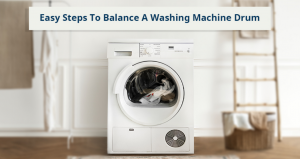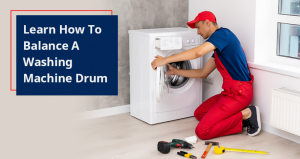How to Balance a Washing Machine Drum? (Easy Steps)
Washing Machines are one of the most commonly used appliances in American homes. Regardless of the time of day, washing machines gently hum and do the job effortlessly and put our minds at ease.
It’s the most common appliance in most homes but then again a sudden increase in noise could be something to worry about. Luckily for you, there are simple steps that will get your washing machine back to normal in no time.

The first step, of course, is to be able to differentiate between a normal degree of humming and sounds of the washing machine drum that can be a cause for alarm or internal malfunction. Now considering most of us are so used to our washers and dryers that the noise has faded into the background of our lives, it is pretty much taken for granted that a washing machine drum loose or unbalanced part inside will be noticeable to our ears.
Before getting down to how to fix such internal issues, it is important to know exhaustively about all that can go wrong to create audible noises and rattling sounds – it can be safely said that all the problems can be traced back to the washing drum of the machine.
What is the Drum of a Washing Machine?
When you open the door of the washing machine, you will notice the inner drum. For front-loading clothes washers, the drum stands upright. Here, you will have to push your clothes inside the door from the front and the whole washing machine drum rotates like a car wheel.
The main factor that you should look for when buying a washing is to determine the type of drum. Washing Machine Drums come in different sizes and this decides the drum capacity. You should ensure that your washing machine drum does not go off track.
Usually, the drum capacity is measured by the net weight of the dry clothes that you wash in each cycle. This is less than the number of clothes that you fit into the washing machine when it is not running.
Unbalanced Drums and Other Internal Controls
The only reason a washing machine starts to shake excessively or make unusual noises due to irregular movements is that its washing machine drum is imbalanced. There are several steps you can take to remedy this irregularity — starting with checking the internal parts for irregularities and the external parts of any damage or impact. It could also simply be because a load of clothes put in the drum is either not correctly filled in or are disproportionate in comparison to the drum space.
It is of utmost importance to look into the matter of excessive shaking or irregular sounds as soon as you notice an issue. Even if the problem is minor and concerned with trivial things such as the size of the load, a consistent period of shaking and unbalance can cause permanent damage to other internal and external parts. For example, when a washing machine tends to vibrate excessively, it tends to “walk”—and it sure can walk a great distance if you’re not paying attention. In such a situation, if by any chance, the machine is close to a wall or any other such hard object, it may cause irreparable damage to other parts of the machine.
Why is the Washer Off Balance?
If you fail to remove the shipping materials, it could cause problems to the spin cycle. This could damage the machine permanently. You should check that the machine is level in the front, sides and the back. Washing machines that are not level will rock during the spin cycle and make the machine off balance.
1) Overloading
The most common and fundamental mistake made by the users is when they fill a washing machine to the brim and allow no breathing space. Also, if the load is “lopsided”, then the cleansing process does not take place as it should have. This usually happens in machines which have a top load feature with an agitator. A brownie point is to check for water in the washing machine drum when not in use.
2) Poor Levelling
Usually, the reason a machine shakes is because of generic, common sense problems such as the machine not sitting on an even plain or leveled floor. External problems such as these can be very easily solved by adjusting a few knobs at the base of the external frame or just by adjusting the positioning of the machine.
3) Shipping Bolts Left Intact
Shipping bolts are external fasteners added only for safe shipping purposes of the appliance. These bolts keep the washing tub rigid while the appliance is in transit and are to be removed when the machine is installed and ready to use. If you can hear rattling noises that seem to be generated from inside the machine, or if you self-installed the washer and skipped a step or two by mistake, there’s a very good chance that the machine is shaking due to these bolts still being secured on the inside.
4) Damage of Internal Parts
Besides the above, smaller parts like belts, bolts, screws, and bearings which lie inside the machine and hold the washing machine drum in place can get damaged due to wear and tear, age and rigorous use. Even one such part malfunctioning can put the entire machine off balance, making them integral to the repair process even if they are the last elements to be checked.
Do front load washers get unbalanced?

Usually a front-load washer would become unbalanced during the wash cycle. This would make the washer make a loud noise or make it shake. Apart from this, the unbalanced washer could fail to spin dry or drain or move across the floor or even if the laundry remains too wet to move to the dryer.
Why washing machine shakes violently during a spin cycle?
The average washing machine spin speed is between 600 to 1400 RPM. If the washing machine is not balanced then it will shake violently during a spin cycle. This will cause water to spill on the floor. You should redistribute the load to solve this issue if the cause is due to too many clothes on a single side of the washer.
How to Balance a Washing Machine Drum

Now you can learn how to balance a washing machine drum:
- Check the Levelling of Your Unit
- Control the Load of the Machine
- Remove the Shipping Bolts
- Internal Parts that May Cause the Washing Machine Drum to Agitate
1. Check the Levelling of Your Unit
All washing machines should be leveled and balanced—either according to the surface they are sitting on or according to the locknuts (adjustable knobs on the base of the legs of the machine) otherwise, they will tend to shake and vibrate unusually.
Stop the machine, re-level according to the instructions given. Then re-start the cycle and observe it for a few rounds to make sure it doesn’t shift off-base again.
How to Tighten Washing Machine Drum
Now that you know that the washing machine drum is loose, here’s how to fix it.
This is a simple enough task, one that requires no tools or expertise. Start by placing a spirit leveler on top of the washer or worktop (this has to be a flat surface), in a way that it points left to right.
Then proceed to loosen the locknuts, which are placed under the machine’s legs, and adjust them by turning them counterclockwise. As you tighten and loosen the nuts, the bubble in the spirit leveler will eventually indicate that the unit is leveled.
Keep in mind, all four legs need to be in contact with the floor at all times. These can usually be adjusted just by twisting them around with our hands and fingers. If this doesn’t help, then you can always use a crowbar to prop-up the machine and move the locknuts with the help of a wrench.
Level the surface
The problem can sometimes be very basic. For example, if the very floor on which the machine is placed isn’t a flat surface and even, then you can you can insert a ply board underneath the appliance —propping the machine on secondary surface which is plain. Choose a ply that is at least three-fourth of an inch thick, so that it can carry the weight of a full load.
If the surface is tilted, slide a board, vinyl sheet or ply on the downward slope, levelling the tilt. You can make simple make-shift shims out of scrap plastic, rubber mats and even composite foam to place under the locknuts which are off-balance. You can use this method to level your unit even if the locknuts/screws have become unusable due to damage or wear and tear.
Unsure of the degree to which the floor is sloped? Use a spirit level to get it just right.
2. Control the Load of the Machine
Every machine has its limits and the same goes for your washing machines as well. If you own a front load washer, it is advised not to fill it to the brim with clothes, rather packing it loosely so that the water can move easily. By filling the washing machine drum completely with clothes, the load doesn’t spin and move properly, reducing the machine’s life.
While spinning, if the quantity of the clothes is correct, the machine still rattles, you need to stop the machine, open the drum and even out the formation of clothes. Try to get the clothes into a compact, leveled formation, then re-start the spin, and keep a close check on the drum.
During both the wash and dry cycle, heavy fabric like jeans and jackets tend to force the drum to lean on one side. Even a tilt because of heavy clothing can be the reason behind a rattling washing machine drum or a machine that ‘walks’. It’s important to club clothes of similar weight together so that the weight is evenly distributed, making sure that the drum is never in contact with the inner walls of the machine.
3. Removing the Shipping Bolts
Step 1: Perform a Simple Test
- Before you try to find the location of the shipping bolt, you need to perform a simple test in order to be sure that the shipping bolts were not removed during installation.
- Open the washer door and press the bottom edge of the stainless-steel basket while firmly applying pressure. If the basket moves about slightly downward and springs back on its own, then the shipping bolts have been removed. But, if there is zero flexibility and no movement, then the shipping bolts are intact and need to be dismantled.
Step 2: Remove the Bolts
- If the bolts have not been removed, then on the back wall of the unit you will see four to five bolts (depending on the model) with plastic spacers. These bolts have to be removed for proper installation and usage. You can use a wrench or a socket to twist and loosen the bolts and then remove them by pulling them out from the washer.
- After removal, keep these safe since they can be reused if the unit needs to be shipped elsewhere. There are pre-attached white caps (right above the bolt holes) which can be used to cover-up the shipping bolt holes.
- If you are not confident about removing the shipping bolts on your own, it is a good idea to get professional help.
4. Check Internal Parts that May Cause the Washing Machine Drum to Agitate for Damage
There are several parts of the machine that help regulate the movement of the drum. These are crucial to the functioning of the washing machine.
The components that you need to be a perfect fit if you need the unit to move flawlessly are as follows:
1) Shock Absorbers
If your machine is a front load, then it is most probably contains one or more shock absorbers. These shock absorbers are between the base frame and the outer tub. You need to keep checking these from time to time, making sure they are not leaking fluid. If even one of the shock absorbers malfunctions, it is advisable to have all of them replaced.
2) Suspension Springs
Both top and front loaders have several suspension springs. This holds the tub to the base or suspends the tub from the top. Make sure each of these is connected. None of the springs should be loose and if even one is damaged, all should be replaced.
3) Snubber Ring
Made up of either plastic or felt, these provide a cushiony base for the tub of a top loader. When these wear out, the tub starts touching the metal base below. Dust on a plastic snubber or clumps on the snubber are signs that the ring is wearing out. You should replace it immediately. You will have to remove the suspension springs to replace the snubber, so it’s ideal to check both together.
4) Dampening Straps
Machines have four dampening straps, holding the washer tub to each of the four corners of the machine. If even one of them fails, the machine will start to wobble and vibrate. They need to be replaced even if one is damaged.
5) Driver Bearings
Some machines have ball bearings between the tub spindle and the motor shafts. If the casing wears out, the bearings become dislodged and the tub will vibrate. This is a major repair and will require a considerable amount of disassembly of the unit. It is better to replace the entire unit if the bearings are worn. Do not attempt a makeshift repair or replacement of just the bearings.
Several components in a washing machine are devoted to controlling the movement and vigor at which your washing machine moves. Peeping into a front-load washer will help determine the speed at which the drum inside is spinning.
All of these components are the internal organs of the unit and are highly sensitive. It is advisable to try all the other options. These include a list of external and generic reasons for a drum vibrating. So before you try and fidget with it, you should consider replacing it with genuine parts.
How to Clean a Washing Machine Drum?
When it comes to cleaning a washing machine drum, you should know that front-loading machines are popular. This is due to the fact that these washing machines are energy efficient and use less detergent than top-loaders. But at times mold grows on it and there could be unpleasant smells. You can give your washing machine a quick clean every month to ensure cleaner clothes too.
Ingredients
- 2 cups vinegar
- 1/4 cup bicarbonate of soda
- 1/4 cup water
- A sponge scourer
Directions:
- Make a mix of bicarbonate of soda and water in a bowl. This would help clean the washing machine. After which, you can pour vinegar into the measuring cup and take these contents to the washing machine.
- You should add the mixture of bicarbonate soda to the detergent container and pour the vinegar in the washing machine drum. Then set the washer to a normal load with hot water. Close the door and let the washing machine do the work for you. Once done the mineral deposits and the mold growth will be removed.
- With the help fo a scouring sponge, you should rub around the opening of the washing machine and remove any residue.
- Now your washing machine is clean and ready to do a load of laundry. Just ensure that you keep it clean once a month.
- After you finished with the wash, spend a few minutes to clean your tumble dryer.
- While you’re at it, you should also remember the importance of a washing machine pan. This will ensure that there is no water under the washing machine drum.
How Do I Clean my LG Smart Drum Washing Machine?
The LG Tub Clean Cycle is a maintenance routine recommended for optimal performance.
You should do this before the Tub Clean cycle:
- First, remove the dispenser and clean the tray and attachments.
- Second, use a solution mix of water and bleach, clean the gasket around the washing machine drum and inside the glass door. (Front Load only)
- Finally, you should drain the unit and clean the drain pump filter. (Front Load only)
Once the initial maintenance steps have been performed, start the Tub Clean cycle.
Does Your Washing Machine Smell?
All you have to do is mix a quarter cup of baking soda with a quarter cup of water. Pour this content into the machine’s detergent container. Then you need to add 2 cups of vinegar to the washing machine drum and run a normal load at high temperature. After which, you can scrub dirty spots with the rough side of the sponge that is dipped in one part vinegar and the other part water.
How to Balance a Top Loading Washing Machine Drum?
You should repair the shock absorbers that weaken or get damaged due to unbalanced load which cause the washer to shake or move. This will cause the machine to make a loud banging sound during the spin cycle.
How a Home Warranty Can Help You?
A home warranty is a policy that covers the repair and replacement costs of a range of home systems and a list of everyday use home appliances, including washing machines. However, it does not include repair costs of damages that occur due to lack of maintenance.
You can use a home maintenance calculator to compare the difference between the actual cost of maintaining all your appliances and systems against the cost of a home warranty policy. But there are certain things that you should know about a home warranty before you invest in one.
Make sure to also read and do detailed research about the company before investing in a policy. Not only should you know the top home warranty companies in the industry, but it is also important to be aware of the companies that are out of business so that you don’t fall prey to a scam.
Bonus Video
RECENT ARTICLES
 Discover First American Home Warranty Locations and What You Need to Know About Their Cover.
Discover First American Home Warranty Locations and What You Need to Know About Their Cover.
 Reviews of Home Warranty Companies Show You How to Determine If Your Home Is Covered
Reviews of Home Warranty Companies Show You How to Determine If Your Home Is Covered




